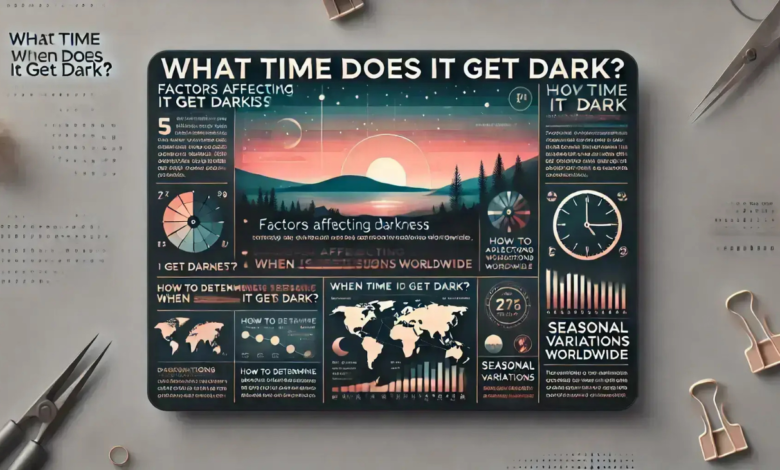What Time Does It Get Dark?

The question “what time does it get dark” is one of those universal curiosities that arise daily in the minds of people around the globe. Whether you’re planning an evening hike, a romantic dinner under the stars, or simply trying to estimate how much daylight remains, understanding when darkness falls is essential. Let’s delve into this topic to explore the factors that determine the time it gets dark, why it varies, and how you can find accurate sunset information for your location.
Factors Affecting the Time It Gets Dark
The timing of darkness depends on various factors, including geographical location, the season, and even atmospheric conditions. Here are the key factors:
Latitude and Longitude
- The farther you are from the equator, the more significant the variation in sunset times throughout the year. Near the poles, darkness can either come very quickly (in winter) or barely at all (during the summer months).
- For example, cities closer to the equator, like Nairobi, experience relatively consistent sunset times year-round, while places like Oslo experience drastic seasonal changes.
Seasonal Changes
- During summer, days are longer due to the tilt of the Earth’s axis, meaning darkness comes later. Conversely, in winter, the days are shorter, and the sun sets earlier.
- For instance, in New York, sunset in December can occur as early as 4:30 PM, but in June, it might not be until 8:30 PM.
Twilight Phases
- Twilight refers to the period between sunset and complete darkness. It is divided into three phases: civil, nautical, and astronomical twilight. Each phase marks a gradual dimming of the light.
- Civil twilight is the brightest and lasts roughly 20-30 minutes after sunset. After this, nautical twilight begins, followed by astronomical twilight, where the sky becomes completely dark.
How to Determine When It Gets Dark
Today, technology makes it incredibly easy to determine what time it gets dark. Here are some effective methods:
Use Online Tools and Apps
- Websites like TimeandDate.com or apps such as Weather Underground and Google Weather provide accurate sunset and twilight timings tailored to your location. Simply type your city or area, and you’ll receive all the relevant details about what time it gets dark.
Check Local Weather Reports
- Many local news channels and weather reports include daily sunrise and sunset timings, helping you plan your day accordingly.
Use a Sundial or Observe Nature
- Although old-fashioned, sundials can give you a rough estimate of the time based on the sun’s position. Alternatively, observing natural cues, like the fading light or animal activity, can also indicate the approach of darkness.
Why Knowing the Time It Gets Dark Matters
Understanding what time it gets dark is more than a matter of curiosity; it’s practical and impactful in several ways:
Outdoor Activities
- If you enjoy outdoor activities like running, hiking, or cycling, knowing the sunset time ensures you can return safely before darkness sets in.
Travel and Safety
- For travelers, especially those in unfamiliar locations, awareness of local sunset timings helps in navigating roads or finding accommodations before nightfall.
Photography and Stargazing
- Photographers and stargazers rely heavily on twilight and darkness to capture stunning shots or enjoy clear views of the night sky. Understanding what time it gets dark can make or break these experiences.
Energy Savings
- Understanding daylight hours can help you optimize energy use, as you’ll know when to switch on lights or adjust heating and cooling systems.
Seasonal Variations Around the World
Different regions experience darkness at varying times due to their position on the globe. Here are some interesting examples:
Tropical Regions
- In tropical areas like Singapore, the time it gets dark remains fairly constant throughout the year, typically around 7:00 PM.
Polar Regions
- At the poles, such as in Antarctica, darkness can last for months during winter, while summer brings almost continuous daylight.
Mid-Latitudes
- In places like London or Sydney, there’s a noticeable change in sunset times between summer and winter, ranging from 4:00 PM in winter to 10:00 PM in summer.
How to Adjust Your Schedule
Planning your day around daylight hours can make life easier and more enjoyable. Here are some tips:
Set Reminders
- Use apps or digital assistants to notify you an hour before sunset so you can wrap up outdoor tasks. Knowing what time it gets dark can help you stay organized.
Carry Essential Gear
- If you’re out late, bring flashlights, reflective gear, or emergency lights to stay safe in low-light conditions.
Plan Evening Activities
- Schedule events like dinner or social outings after considering what time it gets dark to avoid rushing or delays.
Fun Facts About Sunset and Darkness
The Green Flash
- Occasionally, just before the sun sets completely, a green flash of light can appear. This phenomenon is caused by the bending of light in the Earth’s atmosphere.
Shortest and Longest Days
- The shortest day of the year is the winter solstice (around December 21), while the longest is the summer solstice (around June 21).
Cultural Significance
- In many cultures, sunset marks the beginning of religious practices, festivals, or rituals, such as the evening prayer in Islam or lighting candles for Shabbat in Judaism.
Frequently Asked Questions (FAQs)
What Time Does It Get Dark During the Winter?
During winter, darkness comes earlier. For example, in December, places like London may experience sunset as early as 4:00 PM, while tropical regions maintain consistent sunset times around 6:30 PM to 7:00 PM.
How Do Clouds Affect What Time It Gets Dark?
Cloudy weather can make it appear darker earlier, as clouds block sunlight and reduce overall brightness even before the sun sets.
Why Does the Time It Gets Dark Vary?
The variation depends on your geographical location, time of year, and Earth’s tilt. Locations closer to the equator experience less variation compared to higher latitudes.
How Can I Find the Exact Time It Gets Dark?
Use apps like TimeandDate.com or check your local weather service to get accurate sunset and twilight timings for your area.
Conclusion
The question “what time does it get dark” is more than just a search query; it’s a practical consideration that influences our daily lives. From understanding geographical variations to leveraging modern tools for accurate timings, there are plenty of ways to stay informed. So next time you wonder what time it gets dark, you’ll know exactly where to look and how to prepare. Whether it’s for safety, convenience, or leisure, knowing the time it gets dark ensures you can make the most of every day.



